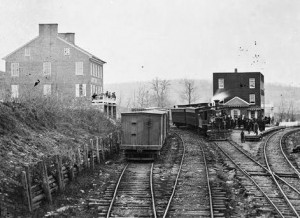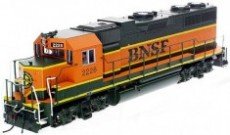Everything on model trains, model railroads, model railways, locomotives, model train layouts, scenery, wiring, DCC and more. Enjoy the world's best hobby... model railroading!
Tips on Collecting Civil War Model Trains
 The Civil War is one of the most fascinating accounts of American history and you can bring all the excitement of our great ancestors through Civil War Model Trains. It goes without saying that this model train is an essential collector’s item and is a must have for a serious hobbyist. Make sure to read history books to understand the train models of the Civil War era so that you can order models that match the exact specifications. I you can you could choose a custom model train builder that builds Civil War Model Trains in limited numbers as it will help you to maintain the exclusivity of your collection.
The Civil War is one of the most fascinating accounts of American history and you can bring all the excitement of our great ancestors through Civil War Model Trains. It goes without saying that this model train is an essential collector’s item and is a must have for a serious hobbyist. Make sure to read history books to understand the train models of the Civil War era so that you can order models that match the exact specifications. I you can you could choose a custom model train builder that builds Civil War Model Trains in limited numbers as it will help you to maintain the exclusivity of your collection.
Benefits Of Using Model Train Turntables
 If you are looking for the perfect model railroad, how about including a model train turntable. Turntables not only bring in the visual perfection to your railroad, but it also offers excellent functionality. Make sure that your model train turntable operates from DCC throttle and the gear drive is motorized to ensure smoother operation and the mounting table should be included with the package. Adding model train turntables to your railroad can give you unlimited route possibilities in many ways you never imaged!
If you are looking for the perfect model railroad, how about including a model train turntable. Turntables not only bring in the visual perfection to your railroad, but it also offers excellent functionality. Make sure that your model train turntable operates from DCC throttle and the gear drive is motorized to ensure smoother operation and the mounting table should be included with the package. Adding model train turntables to your railroad can give you unlimited route possibilities in many ways you never imaged!
Grain Of Wheat Bulbs For Lighting
Val asks readers for advice, so please add your comment to this posting if you can help: "I am new at model railroading. I would like to add some lights to my buildings and some movement to add more interest. I have started with a OO Hornby DCC mixed freight set, I have purchased some grain of wheat bulbs with wires but I am not sure how to wire them up in a series, can you tell me in layman terms please. Any help with adding movement other than the trains would be greatly appreciated." Add your comment to this post.
DCC Power And Lighting
Frank has kindly sent in this contribution:
 If your layout is DCC operated, it has about 12 Volts AC on the rails all the time the power is on. If your layout is DC, there is only power to the rails when the controller is turned on and turned up, and carriage lights will be brighter at higher train speeds because higher voltage is being supplied to the rails. (I mention this because you may be operating DCC trains on a DC layout, as DCC locomotives will also run on DC layouts.)
If your layout is DCC operated, it has about 12 Volts AC on the rails all the time the power is on. If your layout is DC, there is only power to the rails when the controller is turned on and turned up, and carriage lights will be brighter at higher train speeds because higher voltage is being supplied to the rails. (I mention this because you may be operating DCC trains on a DC layout, as DCC locomotives will also run on DC layouts.)
If your lighting set has incandescent filament bulbs (plain old traditional light bulbs), the lights will be on whenever the power to the rails is on. If your lighting is LED, it must have a rectifier bridge (and a resistor) between the lights and the power pickup from the axle. (These may be included in the lighting units.)
Have you made sure your carriages have metal wheels ? Have you made sure that each wire of the lights is connected to a different rail? (On carriages designed to accept lighting, on each axle, the wheel on one side is insulated, either by a little plastic insert in the hub, or by a partly plastic axle.) If you have plastic wheels, it will be necessary to replace them with metal wheel sets.
If your lighting set itself is fully designed for DCC operation, it should be possible to switch the lights on and off from the controller. You may need to discover the DCC code for this if it is not part of the original equipment. If yo have a little electronic knowledge, it would be possible to run wires from the loco to the carriages to a circuit that switches the lights on and off.
Building a Model Railway Station
 Adding a railway station can make a model train layout look very realistic. Use the steps below to build your own railway station from scratch.
Adding a railway station can make a model train layout look very realistic. Use the steps below to build your own railway station from scratch.
- Cut the platform top from a wooden sheet. The length must be greater than the longest train and the width must be less than the distance between adjacent tracks.
- Cut the sides, and glue the top on it. Also create ramps for the platform.
- Paint the platform gray, giving it a textured look.
- Make the station building out of cardboard sheets, or buy a kit set model.
- Design the building by referring to real station structures.
- Other features such as ticket offices, restaurants and benches can also be added.
Obviously, these are just the basics to get you started, and you can certainly add lots of interesting features and details to really bring your model railway station to life.
Switching Freight Cars
 Freight cars are used for the transportation of goods and other bulk commodities. There are six categories of freight trains: gondolas, hoppers, tank cars, well and spine cars, boxcars, and the common flatcar. These trains switch between stops according to two methods: through freight and way freight.
Freight cars are used for the transportation of goods and other bulk commodities. There are six categories of freight trains: gondolas, hoppers, tank cars, well and spine cars, boxcars, and the common flatcar. These trains switch between stops according to two methods: through freight and way freight.
In the through freight method, a switch list is maintained, which defines the train schedule. Trains wait on their designated tracks before arrival and departure. Switching through way freight is complex process. The switch list is very detailed, and defines each car added to the way freight and its location in the train.
What Aspects Of The Hobby Do You Enjoy Most?
Results of the latest poll are in. Visitors to the blog were asked, “What Aspects Of The Hobby Do You Enjoy Most?” Results were as follows:
- Making Scenery (116 Votes)
- Building Structures (105 Votes)
- Operation (96 Votes)
- Planning & Design (87 Votes)
- Wiring And Technical (67 Votes)
- Detailing & Weathering (46 Votes)
- Repairs & Maintenance (33 Votes)
- Historical Research (23 Votes)
- Making Friends (22 Votes)
- Sharing Ideas (22 Votes)
- Other (6 Votes)
Ohio Valley R.R. Historical Foundation Inc
The Chairman of this historical foundation has sent in this update for readers:
We are a 501c3 organization and have been in operation for 6 years, since the last update on the web site besides the 0-6-0 Steam Engine built in 1953 from England we have received an L and N Caboose two Jittneys a old antique flat car with wooden brake shoes and the dining car.
We have secured the Old Train Depot for the Museum and we are now working to restore the 0-6-0 Steam Engine and put most of the parts back on because it was to heavy to move by truck we then will sand blast and paint it, there were only four built two have been scrapped and one is still in England so we have been told.
The Museum has Display Cases which are full of antique items but we also have train layouts for the young and old, Lagrange is one of 3 towns in the USA that has at least 25 trains a day going down the center of main street.
Baseboard Materials
Paul is new to the hobby and asks a question:
“Hi, I’m doing my frist 00 layout and I am a bit confused what to use as the baseboard. The layout will be in my spare room so it won’t be going anywhere so I would like your readers views on this problem. Many thanks.”
Tips For Adding Busy Industries To Your Layout
This is the first video tutorial Colin has ever made, and he admits he was a bit nervous putting it together. Personally I think hes done a fantastic job, and it really shows how much he knows about model railroading. That’s not surprising, after all Colin has been a model railroaders for some 32 years.
In this video Colin shares some of his ideas for adding an industry or two to a layout. I’m sure you’ll enjoy this video and want to share it with friends. Thanks Colin for putting in the time to share your ideas.
Soldering Track Wires
It is often wise to solder your wires on the undersides of the track rails when you are actually laying the track. The temptation can be to lay your track down and then add the wiring sometime later, however the result can end up with ugly wires and little blobs of solder protruding from the sides of the track. Track ties can easily get damaged when using a hot soldering iron.
You can pull the tie from the track and solder your wires to the under-side of the rails. The next step is to file before replacing your sleepers. Another idea for concealing wires is to drilling a small hole and then poke the wires through your bench-work.
You can also use some non-corrosive “Plumbers flux” on the rails applied with a cotton bud before you solder. This will help the solder adhere, and will leave you with a smooth finish as opposed to having blobs everywhere. You can then wash the flux away when you are finished so it is not left on the track rails.
When Do Your Work On Your Layout?
The poll results are in. A total of 395 model railroaders responded to the question “When Do Your Work On Your Layout?”
- All Year Round (54%, 214 Votes)
- Mainly In Cooler Months (26%, 103 Votes)
- I Don’t Have A Layout Yet (16%, 64 Votes)
- Mainly In Warmer Months (4%, 14 Votes)
HO scale 1:87 DCC System Compatability
Anil asks readers:
“WI would like to know whether two dcc systems can be used on the same layout of same make or different? For example, a layout using digitrax can Bachman be added? Can two bachman EZ dcc system or for digtitrax be used on the same layout?”
World War I Tank Locomotive
Gary sent in these photos of a WWI tank train and wondered if anyone knew anything about this type of model:
“I have been searching for information about a Military Lionel Locomotive with 2 cars. I have attached a couple of photos I took of the train. It was my wife’s grandfather train when he was a boy I have no history and cannot find any information about the train. The tank locomotive has a light that flashes as the turret moves back and forth. I’d would appreciate it if someone might be able to provide more information on this model. There is no serial or model number in the electric motor except information about Lionel. ”


















